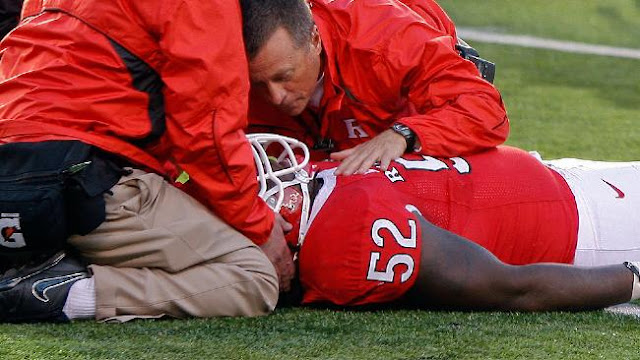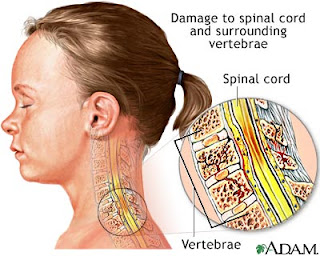Responding to a Cervical Spinal Cord Injury
A catastrophic cervical spinal cord injury occurs with structural distortion of the cervical spinal column due to actual or potential damage to the spinal cord. Damage above the C5 vertebrae in the spinal column results in the greatest risk of immediate sudden death for an athlete. Above this level, damage may impair the spinal cord’s ability to transmit respiratory or circulatory control from the brain. Effective acute care is critical in preventing permanent dysfunction or death in an athlete as a biochemical cascade of events can occur during the initial 24 to 72 hours post-injury.
Any of the following symptoms warrants the initiation of a spinal cord injury management protocol:
– unconsciousness or altered level of consciousness
– bilateral neurologic complaints
– significant midline spine pain
– obvious spinal column deformity
Treatment:
 When treating a cervical spinal injury, stabilize the spine in a neutral position immediately. Avoid applying traction to the cervical spine to create as little motion as possible. After manual stabilization of the spine, immobilizers such as foam blocks or straps may be used. If rescue breathing becomes necessary, the person with the most training and experience should establish an airway using the safest technique.
When treating a cervical spinal injury, stabilize the spine in a neutral position immediately. Avoid applying traction to the cervical spine to create as little motion as possible. After manual stabilization of the spine, immobilizers such as foam blocks or straps may be used. If rescue breathing becomes necessary, the person with the most training and experience should establish an airway using the safest technique. If the athlete is in a position that prevents treatment of the airway, slowly realign the cervical spine. However, stop movement if the athlete experiences increased pain, neurologic symptoms, or muscle spasms. Prepare for transport to the nearest hospital. The team physician or athletic trainer should accompany the athlete to help guide equipment removal.
If possible, remove equipment to clear access to the airway. Remove helmet and shoulder pads if necessary.
Prevention:
1) Use appropriate technique when tackling or engaging in contact (keep your head up)
2) Medical personnel should be able to recognize and respond promptly to cervical spinal injuries
3) Ensure equipment hardware is not rusted and is repeatedly inspected for maintenance
Athlete may return to play only after full tissue healing, neurologic recovery, and medical clearance from a physician.
Watch Iyad, physiotherapist at InSync, demonstrate how to mobilize a stiff neck with a quick and easy exercise:
Watch Iyad, physiotherapist at InSync, demonstrate how to mobilize a stiff neck with a quick and easy exercise:
Casa, Douglas J., et al. “National Athletic Trainers’ Association Position Statement: Preventing Sudden Death in Sports.” Journal of Athletic Training, vol. 47, no. 1, 2012, pp. 96–118., doi:10.4085/1062-6050-47.1.96.
InSync Physiotherapy is a multi-award winning health clinic helping you in Sports Injuries, Physiotherapy, Exercise Rehabilitation, Massage Therapy, Acupuncture & IMS.


